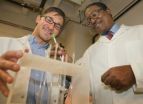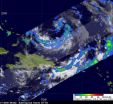(Press-News.org) WASHINGTON, DC-In the weeks leading up to the 2010 midterm elections, five forecasters or teams of forecasters offer models and predictions for the House in the most recent issue (October 2010) of PS: Political Science and Politics, a journal of the American Political Science Association. The models offer a broad consensus that the Republicans will make substantial gains in the House, although there is not a consensus over how large those gains will be. A 30-seat spread between the low and high end of the seat change forecast range exists, with two forecasters giving an edge to Democrats maintaining their control of the House and three forecasters anticipating Republicans retaking the chamber.
James Campbell of the University at Buffalo, SUNY, presents a "seats in trouble" model for his forecast. The model is based on the Cook Political Report's district-by-district assessment of the status of House races. He finds that the more seats a party has that are rated as toss-ups or worse before Labor Day, the more seats they actually lose in November. His model combines Cook's expert handicapping of districts with national variables such as presidential approval and the number of seats a party holds going into the election. Campbell's model combines the in-depth analysis of the Cook Report with the rigorous historical analysis of national statistical models. Based on his model, he forecasts that Democrats will lose 51 or 52 seats, allowing the Republicans to regain a majority.
Models created by Alan Abramowitz (Emory) and Joseph Bafumi (Dartmouth), Robert S. Erikson (Columbia), and Christopher Wlezien (Temple) corroborate the prediction of steep Democratic losses. Abramowitz uses the generic ballot and presidential approval to measure the national political climate, estimating that Republicans will gain 43 seats in the House. He further offers a forecast for the Senate, predicting a Republican gain of four seats. Bafumi, Erikson, and Wlezien give the Republicans a 79% chance of retaking the House, forecasting a 229 Republican to 206 Democratic split of seats, but they note that there is a wide dispersion of possible outcomes, and that seemingly minor variation in the national vote can have major consequences for the distribution of seats.
In contrast, the forecast by Michael Lewis-Beck (University of Iowa) and Charles Tien (Hunter College and CUNY) and the forecast by Alfred Cuzán (West Florida University) both predict that the Democrats are likely to maintain their control of the House. Lewis-Beck and Tien rely on established voting behavior theory in the formulation of their model and estimate a Democratic loss of only 22 seats, allowing the party to retain their majority. Cuzán uses a structural model relying on national-level variables and election outcomes as far back as 1914 to forecast Democratic losses of 27 to 30 seats, staving off Republican attempts to retake control. However, this model leaves a one in three or four chance that the Democrats will lose at least 40 seats, reducing them to a minority status.
Stepping beyond the collection of congressional predictions is Carl Klarner's (Indiana State University) forecast of state legislative elections. He calls attention to the 43 state legislative elections that will be held this November, noting that many of the winners will have the responsibility for drawing new district lines based on the 2010 census. According to his model, Republicans will gain control of 11 legislative chambers, leaving them with a total of 46 of 98 partisan chambers, and the Midwest is shaping up to be a battleground of note.
Primaries held in a number of states in mid-September offer a taste of how hotly contested the midterm elections in November are likely to be. Whether Democrats or Republicans ultimately assume control of the House, Campbell notes that this majority is likely to be much narrower than the current Democratic majority, which may present a roadblock to the Obama administration's legislative agenda and will quite probably make control of the House a real question again in 2012.
###
The American Political Science Association (est. 1903) is the leading professional organization for the study of politics and has over 14,000 members in 80 countries. For more news and information about political science research visit the APSA media Web site, www.politicalsciencenews.org.
Election forecasts favor Republican gains in midterm
2010-10-08
ELSE PRESS RELEASES FROM THIS DATE:
Structure of plastic solar cells impedes their efficiency
2010-10-08
A team of researchers from North Carolina State University and the U.K. has found that the low rate of energy conversion in all-polymer solar-cell technology is caused by the structure of the solar cells themselves. They hope that their findings will lead to the creation of more efficient solar cells.
Polymeric solar cells are made of thin layers of interpenetrating structures from two different conducting plastics and are increasingly popular because they are both potentially cheaper to make than those currently in use and can be "painted" or printed onto a variety ...
Stanford-led study disproves link between genetic variant, risk of coronary artery disease
2010-10-08
STANFORD, Calif. — A genetic marker touted as a predictor of coronary artery disease is no such thing, according to a study led by researchers at the Stanford University School of Medicine.
The massive international study, published online Oct. 7 in the Journal of the American College of Cardiology, assessed the predictive value of a leading genetic assay for risk of atherosclerosis.
The study analyzed the data from more than 17,000 patients with cardiovascular disease and 40,000 others to assess whether carrying a particular variant of the KIF6 gene indicated a greater ...
New tool in the fight against tuberculosis
2010-10-08
Researchers at the Institute for Genomic Biology at the University of Illinois have developed a way to harness the prodigious quantities of both genomic and metabolic data being generated with high-throughput genomics and other techniques. They have developed an algorithm that automatically integrates both data sets. The model, called probabilistic regulation of metabolism (PROM), enables researchers to perturb a given regulatory gene or metabolic process and see how that affects the entire network.
"PROM provides a platform for studying the behavior of networks in a ...
Thoughts about time inspire people to socialize
2010-10-08
Does thinking about time or money make you happier? A new study published in Psychological Science, a journal of the Association for Psychological Science, finds that people who are made to think about time plan to spend more of their time with the people in their lives while people who think about money fill their schedules with work, work, and—you guessed it—more work.
To find out how thinking about time or money makes people feel, Cassie Mogilner of the University of Pennsylvania designed an experiment, carried out online with adults from all over the United States, ...
Brown University chemists simplify biodiesel conversion
2010-10-08
PROVIDENCE, R.I. [Brown University] — As the United States seeks to lessen its reliance on foreign oil, biodiesel is expected to play a role. According to the National Renewable Energy Laboratory, a branch of the Department of Energy, biodiesel "represents a significant energy resource and could someday supply 3 percent to 5 percent of the distillate fuel market."
One major obstacle to achieving that goal is figuring how to efficiently convert the abundant stocks of waste vegetable oil (oil used after cooking French fries, for example) into biodiesel fuel. Current techniques ...
Melanoma uses body's immune system to spread to lungs
2010-10-08
The way melanoma cells use the immune system to spread and develop into lung tumors may lead to a therapy to decrease development of these tumors, according to Penn State researchers.
"Melanoma is the most aggressive and metastatic form of skin cancer," said Gavin Robertson, professor of pharmacology, pathology, dermatology and surgery in the Penn State College of Medicine. "Therefore, identifying proteins and molecular mechanisms that regulate metastasis is important for developing drugs to treat this disease."
Metastasis is a complex process in which cancer cells ...
MIT researchers develop a better way to see molecules at work in living brain cells
2010-10-08
CAMBRIDGE, Mass. -- By creating a better way to see molecules at work in living brain cells, researchers affiliated with MIT's Picower Institute for Learning and Memory and the MIT Department of Chemistry are helping elucidate molecular mechanisms of synapse formation. These studies could also help further understanding of how synapses go awry in developmental diseases such as autism and Fragile X syndrome. The study will appear in the Oct. 7 issue of Cell.
Using the new technique, which is more accurate and sensitive than existing methods, the researchers found that ...
US invested $139 billion in health research in 2009
2010-10-08
WASHINGTON—October 7, 2010—The U.S. invested $139 billion last year in health research from all public and private sources, according to Research!America's latest annual estimate. That amount represents only 5.6% of the $2.47 trillion overall U.S. health spending in 2009—or 5.6¢ of every health dollar—which varies no more than 0.2% from 2005 levels.
The estimate is available here: http://www.researchamerica.org/uploads/healthdollar09.pdf.
The 2009 investment grew by only 0.1% over 2008. This small increase can be attributed largely to the federal stimulus funding ...
NASA satellites see Otto become a tropical storm
2010-10-08
NASA satellites have collected data as the Atlantic Ocean's Tropical Depression 17 has undergone two changes in less than 24 hours. Since Oct. 6, the depression has strengthened and has tropical storm-force winds and has morphed from a sub-tropical storm into a tropical storm.
After a United States Air Force Reserve reconnaissance flight subtropical depression seventeen was upgraded by the National Hurricane Center (NHC) to subtropical storm Otto on Oct. 6 at 5 p.m. EDT (2100 UTC). On Oct. 6 and 7, NASA's TRMM and Aqua satellites were flying overhead measuring very cold, ...
Saturn's icy moon may keep oceans liquid with wobble
2010-10-08
Saturn's icy moon Enceladus should not be one of the most promising places in our solar system to look for extraterrestrial life. Instead, it should have frozen solid billions of years ago. Located in the frigid outer solar system, it's too far from the sun to have oceans of liquid water -- a necessary ingredient for known forms of life -- on its surface.
Some worlds, like Mars or Jupiter's moon Europa, give hints that they might harbor liquid water beneath their surfaces. Mars is about 4,200 miles across and Europa almost 2,000 miles across. However, with a diameter ...


